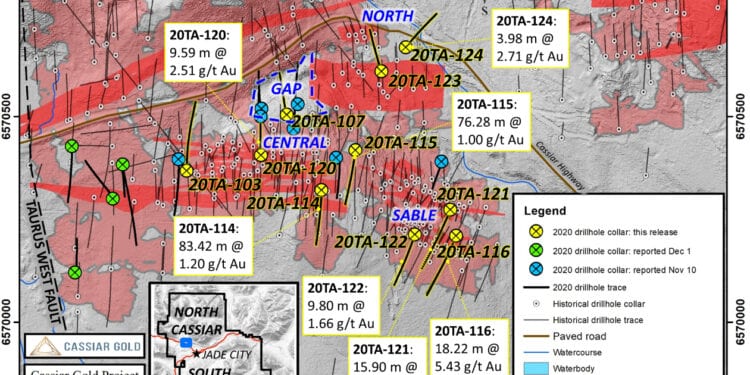Hits 18.22M Of 5.43 g/t And 83.42M Of 1.20 g/t Gold
Cassiar Gold Corp. (TSXV:GLDC) has announced the assay results for the remaining 10 diamond drillholes from its recently-completed 2020 drill campaign on its 100%-owned Cassiar Gold Property in northern British Columbia, Canada.
The primary goal of the programme was to confirm and expand the near-surface resource of one million ounces at 1.43 g/t Au estimated at Taurus in 2019.
In total, 24 drillholes (4,718m) were drilled at North Cassiar from August to October, 2020. Results from 14 drillholes from the 2020 campaign have already been reportedl
Highlights and significant results for this release:
Sable Zone infill and extension drilling:
- Drillhole 20TA-116: 5.43 g/t Au over 18.22 m including 22.40 g/t Au over 0.75 m and 2.77 g/t Au over 13.55 m at the southeast extent of the Taurus Deposit
- Drillhole 20TA-121: 1.34 g/t Au over 15.90 m, as well as 53.50 g/t Au over 0.46 m and 32.20 g/t Au over 0. m
Taurus Zone infill and extension drilling:
- Drillhole 20TA-114: 1.20 g/t Au over 83.42 m
- Drillhole 20TA-120: 2.51 g/t Au over 9.59 m
“These are our best results from Taurus yet. The remarkable intercept lengths with attractive grades within and around the Taurus resource enhance our confidence in the deposit and its potential for expansion. As we turn our attention towards our high-grade targets at South Cassiar, I couldn’t be happier with the Taurus campaign and the results this team has put together,” commented Marco Roque, CEO of Cassiar Gold.
The 2020 Taurus drill programme was designed to increase confidence in historical assay results, to test potential for extension laterally and at depth, or to infill gaps within the 2019 Taurus bulk-tonnage resource model.
Four drillholes were planned to target the Sable area, one of the highest-grade zones of the Taurus Deposit. The Sable area is composed of a series of concordant, west-northwest-striking, gold-bearing shear vein structures with sinistral offset. Shear veins are continuous over several hundred metres and are accompanied by subvertical east-west extensional veins which collectively form bulk mineralised zones. Along the southern margin of the Sable area, historical drilling has been largely confined to the upper 50 m of basalt, with few drillholes extending to greater depths or expanding southward.
Drillholes 20TA-116, 20TA-121 and 20TA-122 were drilled southward on parallel southwest-trending vertical sections 50 m apart. These three drillholes were designed to increase confidence in shallow historical drillhole results, infill modest gaps in the current resource shell, as well as test for a southern extension of mineralization past the extent of the 2019 resource model. 20TA-116 returned multiple broad zones including 5.43 g/t Au over 18.22 m (Table 1). 20TA-121 and 20TA-122 targeted the same south Sable domain, intersecting zones of 1.34 g/t Au over 15.90 m and 1.66 g/t Au over 9.80 m, respectively. Drilling at south Sable confirmed that mineralization does extend beyond the southern boundary of the 2019 resource shell. Drillhole 20TA-115 was designed to test a gap in the lower part of the resource just above the base contact with underlying sediments. Results returned 1.00 g/t Au over 76.28 m and 0.99 g/t Au over 25.40 m within the resource grade shell, as well as 0.91 g/t Au over 14.10 m below the grade shell.
The final two drillholes of the programme tested North Taurus – an area of low-density drilling proximal to historical workings. Drilling was intended to test continuity of mineralization to the north and northeast.












